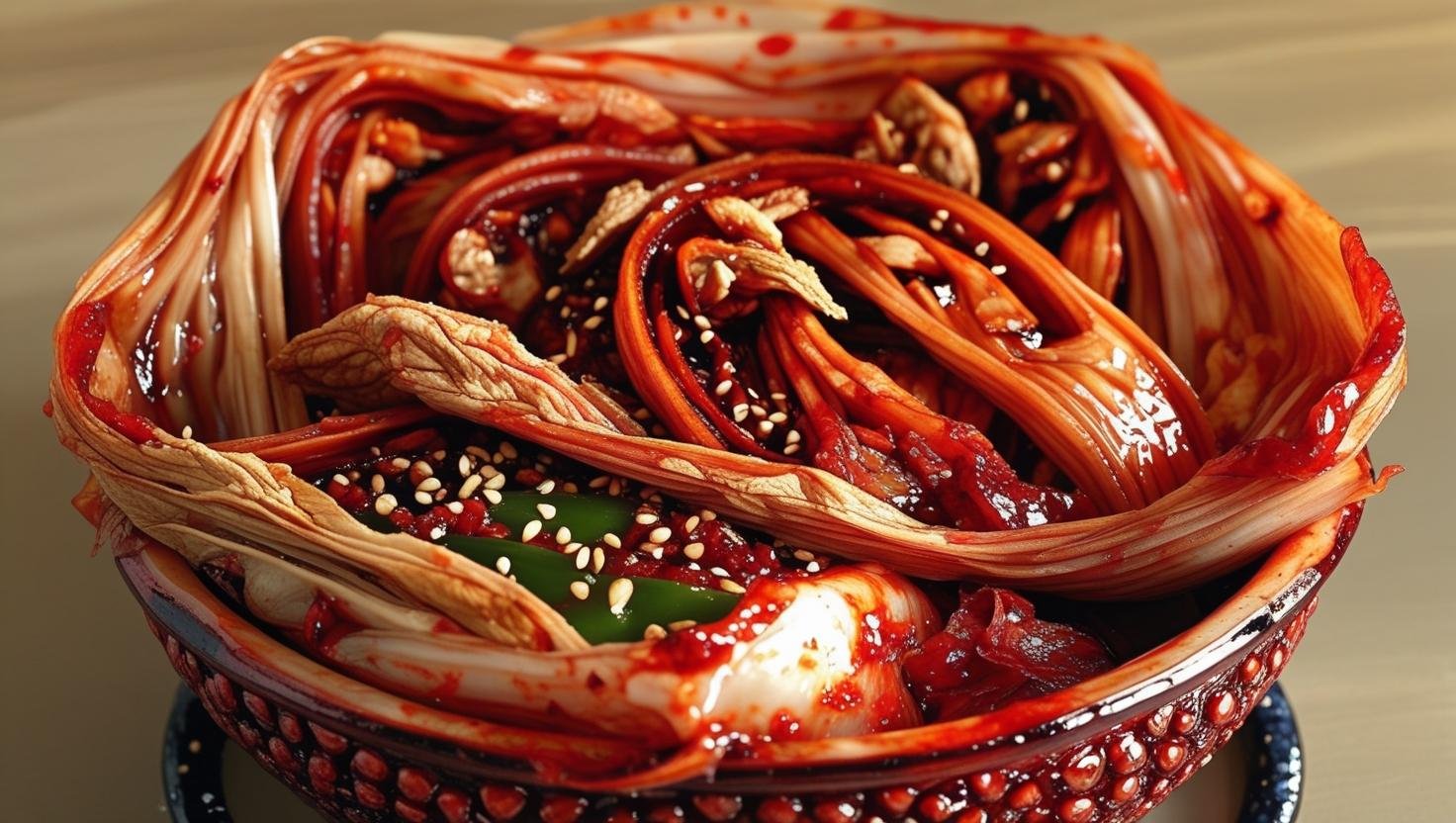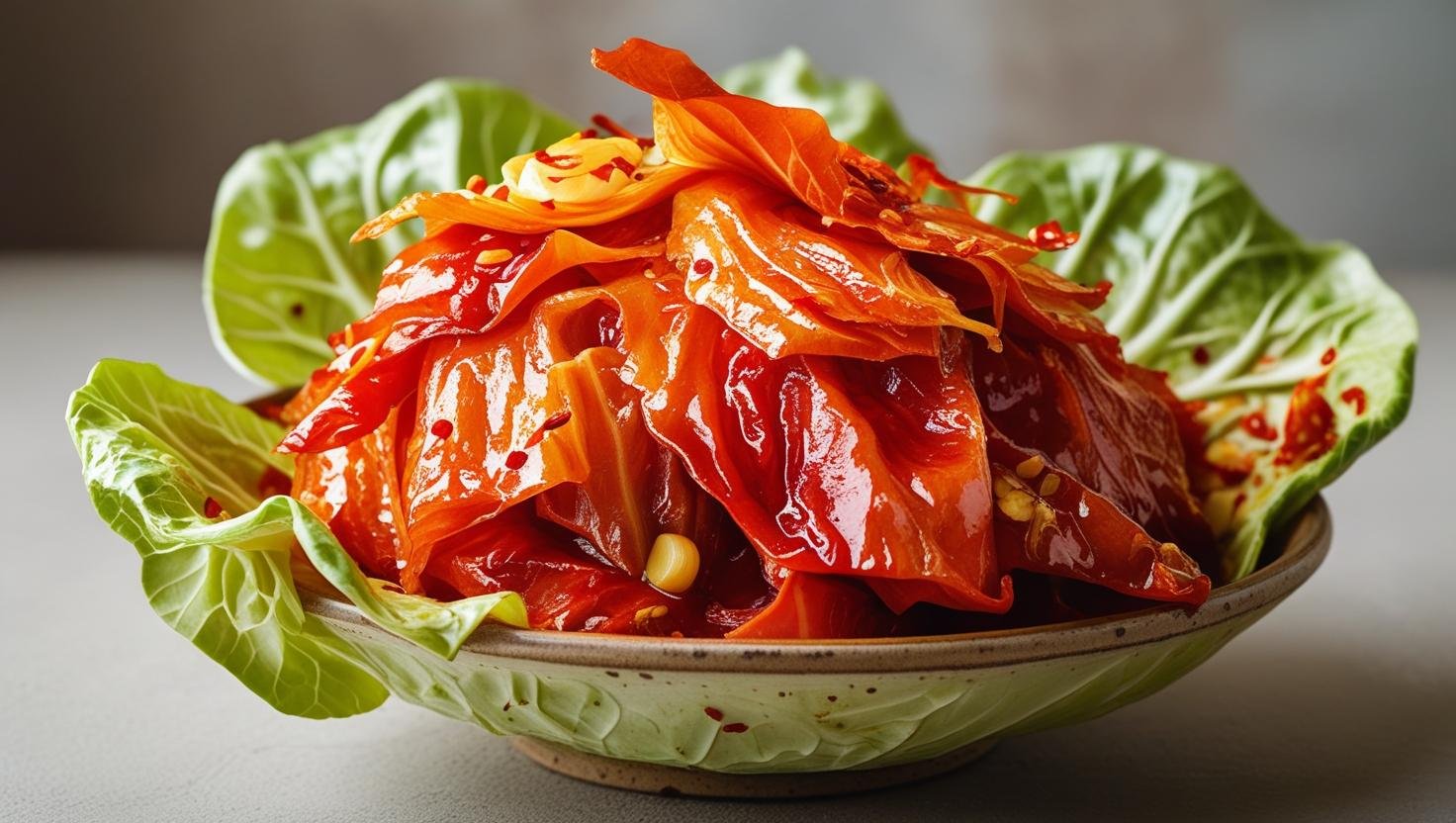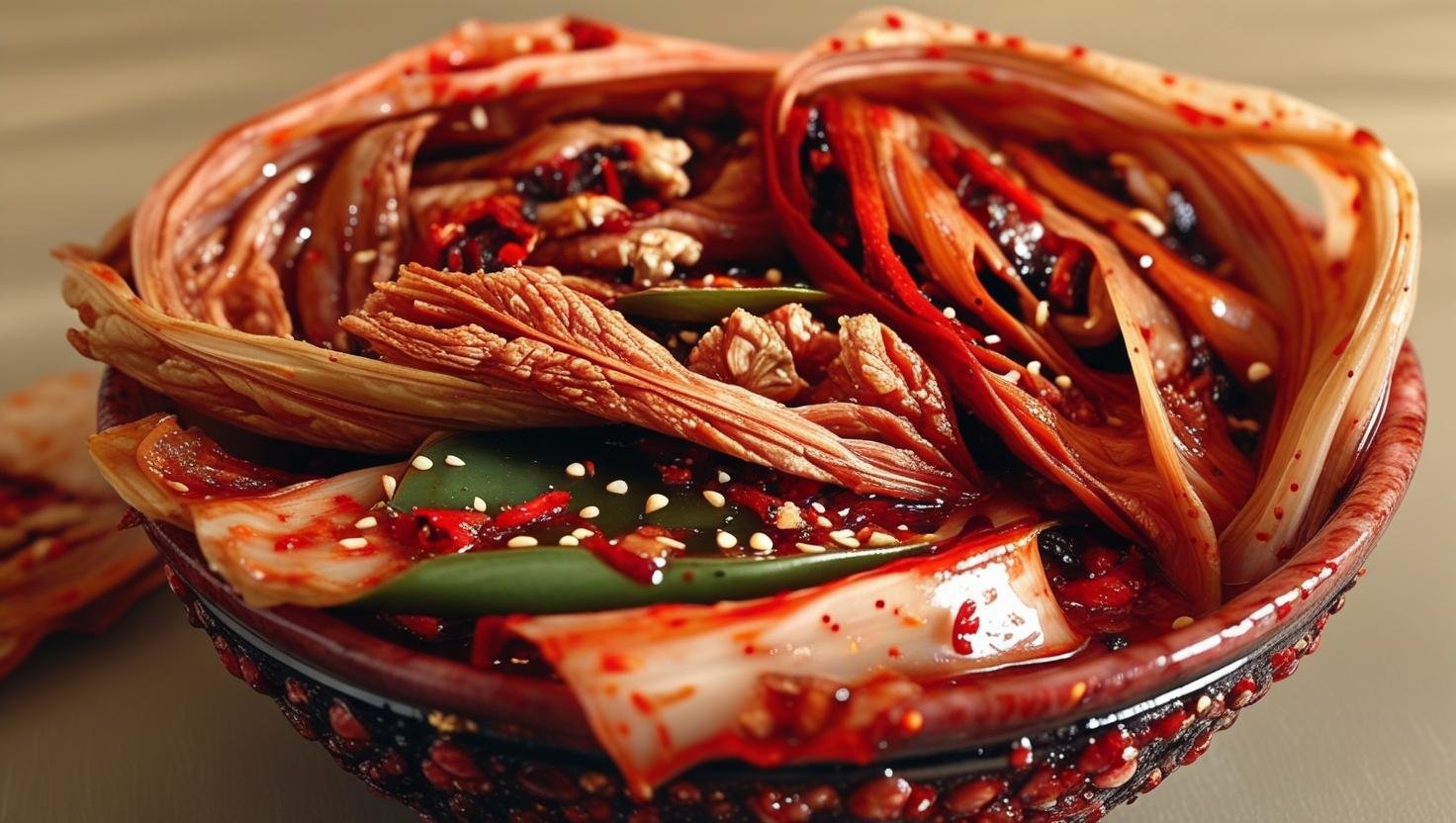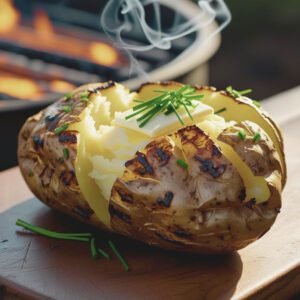The Ultimate Guide to Making Napa Cabbage Kimchi at Home 🥬🌶️
Table of Contents
ToggleA traditional Korean recipe with modern tips for every kitchen
If you’ve ever wanted to try your hand at making Napa Cabbage Kimchi at home, you’re in the right place. Kimchi is more than just a dish—it’s a jar of heritage, healing, and heart. Whether you’re Korean, Korean-American, or simply kimchi-curious, I’m here to walk you through every step, from salting and seasoning to fermenting and storing. Along the way, I’ll share family wisdom, kitchen discoveries, and those little lessons that come from years of hands-on experience. 👩🍳

What is Napa Cabbage Kimchi?
Napa Cabbage Kimchi (baechu kimchi) is Korea’s signature fermented vegetable dish. At its heart, it’s made from salted cabbage leaves, a vibrant seasoning paste, and patient fermentation—a harmony of spicy, sour, and umami notes that awaken any meal. In Korean homes, this classic banchan (side dish) is more than a condiment; it’s an everyday essential loaded with probiotics and rich flavor.
While there are endless kimchi variations, this guide zeroes in on the classic napa cabbage style: think gochugaru (Korean chili flakes), fish sauce, and sometimes saeujeot (fermented shrimp). Vegan options are also included for a plant-based spin—because kimchi should be for everyone. 🌱
Ingredients You’ll Need (And Why) 🛒
Here’s what goes into traditional napa cabbage kimchi, plus a quick note on why each ingredient matters:
Vegetables & Aromatics
- 4 kg napa cabbage (halved or quartered, stems intact for structure) 🥬
- Korean radish (optional, for crunch)
- 140g carrots 🥕
- 75g onion (blended for paste) 🧅
- 90g chives
- Scallions
- 42g garlic 🧄
- Minced ginger
Salting
- 1.5 cups sea salt (or 97g coarse salt) 🧂
- 16 cups water (for saltwater brine) 💧
- Extra coarse sea salt (for layering between leaves)
Kimchi Paste
- Glutinous rice flour (for sticky rice paste)
- 360ml water
- 141g gochugaru (Korean red chili flakes) 🌶️
- 3.5 Tbsp fish sauce, 2 Tbsp saeujeot, or myulchiaekjeot
- Optional: Ripe pear (for mild sweetness) 🍐
- Vegan version: Soup soy sauce or gimajang
Optional Seasoning Boosters
- Sand lance sauce or anchovy fish sauce (for deeper umami)
- Dashima broth or kombu strips (added to brine or paste)
- Kimchi paste base: blended onion, garlic, chili, and rice paste
Step-by-Step: How to Make Napa Cabbage Kimchi 👣
1. Prep the Cabbage
Slice the napa cabbage into halves or quarters, keeping the stem attached so the leaves stay together. Rinse well.
In a big mixing bowl, dissolve the salt in water to make a brine. Soak the cabbage pieces in the brine and generously sprinkle extra salt between each leaf. Let this sit for 4–6 hours, turning the pieces every hour or two. This draws out moisture, allowing the leaves to wilt while staying crisp—a must for great kimchi texture.
After brining, rinse the cabbage thoroughly three times to wash away excess salt. Let it drain and dry for about 30 minutes. ⏳
2. Make the Kimchi Paste
In a small pot, whisk the glutinous rice flour into 360 ml of water and cook on low, stirring, until thick and pudding-like. Let it cool completely.
To your cooled rice paste, add:
- Minced garlic, grated onion, and ginger
- Gochugaru, fish sauce, and saeujeot or soy sauce
- Optional: blended pear or onion for sweetness
Mix everything together until you have a fragrant, bright red paste. This is where all the flavor comes alive. ✨
3. Assemble the Kimchi
Slip on kitchen gloves. Take each piece of brined cabbage and gently coat each leaf with your paste. Press down lightly so the mixture clings to every crevice. This is the meditative part—don’t rush it! 🧤
Layer your seasoned cabbage into a food-safe kimchi container or a 1-gallon jar, pressing down to remove air pockets. This helps prevent spoilage and ensures a good ferment.
4. Ferment and Store
Leave the container at cool room temperature (around 3°C if possible) for 1–2 days to kickstart fermentation. You’ll notice bubbles and that classic tangy aroma. 🫧
Afterward, move the kimchi to the fridge or a kimchi refrigerator to slow down the ferment. After about 3–4 days, it’s ready to taste. Like your kimchi more aged? Let it develop for 2 weeks or longer—the flavor only gets deeper. 🕰️

How to Serve and Enjoy Kimchi 🍽️
Kimchi is endlessly versatile. Serve it:
- As a side dish (banchan) with rice 🍚
- Stirred into fried rice or bibim guksu (spicy cold noodles)
- In kimchi pancakes (kimchijeon) or stews (jjigae) 🥘
- Paired with tofu (dubu kimchi) or used as a flavorful wrap 🥢
As it continues to ferment, kimchi’s flavor changes—from fresh and crunchy to bold, tangy, and deeply savory. Older kimchi is especially wonderful for cooking.
Tips from My Kitchen 📝
- Use a mandoline for evenly sliced veggies.
- Don’t over-brine—too long and the cabbage gets limp and too salty.
- For vegan kimchi, always taste your paste before adding. Soup soy sauce and gimajang deliver great depth.
- Press your kimchi down in the container to keep out air and prevent mold.
- Set aside a small jar to enjoy early, and let the rest age for extra complexity.
Final Thoughts 💬
Making Napa cabbage kimchi isn’t just about following a recipe—it’s a way of caring for yourself and connecting with tradition. It brings bold Korean flavors right into your home and rewards you with jars full of nutrition, culture, and heart. Whether you’re fermenting your first batch or perfecting a family recipe, I hope this guide helps you every step of the way.
And here’s a little secret: every jar of kimchi gets better with practice, memories, and your own special touch. You’ll find yourself tasting, tweaking, and passing along the tradition with each batch. ❤️
Ready for more? Try vegan kimchi, whole cabbage versions, or small-batch recipes perfect for fridge space and flavor control. If you found this guide helpful, bookmark it or share it—because kimchi, like all good things, is even better enjoyed together. 🙌
(FAQs) about Napa Cabbage Kimchi
1. How long does homemade kimchi last in the fridge?
Properly stored in an airtight container, homemade kimchi can last anywhere from 1 to 3 months in the fridge—sometimes even longer! The flavor will become tangier and deeper as it continues to ferment. If it develops mold, a slimy texture, or an off smell, it’s time to discard it.
2. Can I make kimchi without fish sauce or fermented shrimp?
Absolutely! For a vegan or vegetarian kimchi, swap the fish sauce and saeujeot for soup soy sauce, gimajang, or even a splash of tamari. These alternatives add savory depth without seafood, so you can still enjoy classic flavor with a plant-based twist.
3. Why does my kimchi taste too salty or too bland?
The saltiness of kimchi depends on your brining and rinsing process. If it’s too salty, try rinsing the cabbage more thoroughly before seasoning. If it’s bland, your seasoning paste may need more gochugaru, garlic, or fish sauce. Remember, kimchi’s flavor will also intensify as it ferments.
4. What do I do if my kimchi smells very strong or sour?
Kimchi is known for its bold aroma, but if it smells uncomfortably pungent or overly sour, it may be over-fermented. Don’t worry—overripe kimchi is still perfect for cooking! Use it in kimchi jjigae (stew), fried rice, or pancakes for extra flavor.
5. Can I add other vegetables to my kimchi?
Definitely! Classic napa cabbage kimchi often includes carrots, Korean radish, and chives, but you can get creative. Try adding thinly sliced daikon, Asian pear, or even a handful of fresh herbs for your own signature touch. Kimchi-making is all about tradition—and a little bit of kitchen fun!

Napa Cabbage Kimchi (Baechu Kimchi)
Ingredients
- Vegetables & Aromatics
- 4 kg napa cabbage whole or quartered, stem intact
- 140 g carrot julienned
- 75 g onion blended or finely grated
- 90 g chives chopped
- 1 Korean radish julienned (optional)
- 4 –5 scallions chopped
- 42 g garlic minced
- 1 thumb-sized piece ginger minced
- Salting
- 1.5 cups sea salt or 97 g coarse salt
- 16 cups water for saltwater brine
- Extra coarse sea salt for sprinkling between cabbage leaves
- Kimchi Paste
- 2 Tbsp glutinous rice flour
- 360 ml water for rice paste
- 141 g gochugaru Korean red chili flakes
- 3.5 Tbsp fish sauce
- 2 Tbsp saeujeot fermented shrimp or myulchiaekjeot (optional)
- 1 ripe pear mashed (optional, for sweetness)
- Vegan option: 3 Tbsp soup soy sauce or gimajang
- Optional Flavor Boosters
- 1 Tbsp sand lance sauce or anchovy fish sauce
- Dashima kelp or kombu strips (add to brine or paste)
Instructions
- Prep the Cabbage
- Slice napa cabbage into halves or quarters, keeping the stems intact.
- Rinse thoroughly.
- In a large bowl, dissolve 1.5 cups salt in 16 cups water.
- Place cabbage in brine; sprinkle extra salt between leaves.
- Let sit 4–6 hours, turning occasionally.
- Rinse cabbage 3 times in cold water. Drain for 30 minutes.
- Make the Kimchi Paste
- In a small pot, whisk glutinous rice flour into 360 ml water.
- Cook over low heat, stirring, until thickened. Let cool.
- In a bowl, combine cooled rice paste, gochugaru, fish sauce, saeujeot (or vegan alternative), garlic, ginger, blended onion, and optional pear. Mix well until bright red and fragrant.
- Assemble the Kimchi
- Wearing gloves, gently coat each cabbage leaf with paste.
- Tuck carrot, radish, chives, and scallions between leaves for flavor and crunch.
- Fold and pack cabbage tightly into a food-safe container or glass jar, pressing out air.
- Ferment
- Leave at cool room temperature (about 3°C/37°F if possible) for 1–2 days.
- Look for bubbles and a tangy aroma.
- Transfer to refrigerator to slow fermentation.
- Taste after 3–4 days. For deeper flavor, let age 2 weeks or more.
Notes
Storage & Reheating Tips
- Storage: Store kimchi in airtight containers in the fridge up to 3 months. Flavor continues to develop.
- Serving: Always use clean utensils to avoid contamination.
- Reheating: Kimchi is best enjoyed cold or at room temp, but older kimchi is delicious in stews, pancakes, and fried rice.
Start a small jar to eat fresh, and let the rest ferment longer for deeper flavor.




